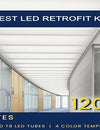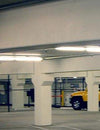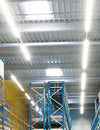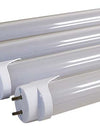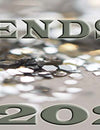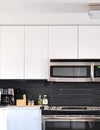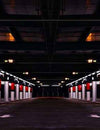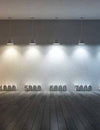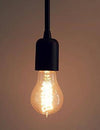
Fluorescent tubes are still an inexpensive option for T8 lighting fixtures, but fluorescent lighting has it's drawbacks. Here are some good reasons to consider converting your fluorescents to new LED tubes.
- The Problems with Ballasts
Fluorescent lamps require a ballast to stabilize the current through the lamp, and to provide the initial voltage required to start the fixture. Electromagnetic ballasts with a minor fault can produce an audible humming or buzzing noise. This process also requires a noticeable warm-up time that varies depending on the light. Ballasts can be costly to replace.
Newer LED lamps do not use a ballast. All drivers are contained within the tube. This produces a lamp that never buzzes and requires no maintenance. LEDs also have virtually no warm-up time. They reach maximum brightness near instantaneously.
- Fluorescent Tubes Emit UV Radiation
Fluorescent lamps emit a small amount of ultraviolet (UV) light. They generate visible light because the tube is coated with a layer of phosphor which glows when it comes into contact with UV radiation. Ultraviolet light can affect paintings, especially watercolors and many textiles. Art work must be protected from fluorescent light by additional glass or transparent acrylic sheets put between the fluorescent lamp(s) and the painting.
LEDs produce a very narrow spectrum of visible light without the losses to radiation (IR or UV) associated with fluorescent lighting, meaning that most of the energy consumed by the light source is converted directly to visible light.
- Fluorescent lights are omnidirectional
Omnidirectional lights produce light in 360 degrees. When a fluorescent tube is lit, it gives off lighting all the way around the tube (including inside and to the back of the light fixture). This means that only about 60-70% of the actual light being given off by the fluorescent lamps is being used. The other 30-40% is wasted.
LEDs are directional lights. Directional lighting aims at a specific object or work surface. LED tubes are shielded to produce a 180 degree range of light, limiting the amount of light wasted.
- Frequent on/off Causes Fluorescents to Fail
If the lamp is installed where it is frequently switched on and off, it will age rapidly. Generally they exhibit an end-of-life phenomenon known as cycling where the lamp goes on and off without human input prior to eventually failing entirely.
LEDs fail by dimming gradually over time.
- Fluorescents Lack Cold Temperature Tolerance
Fluorescent lamps operate best around room temperature. At below-freezing temperatures fluorescent lamps may not start. They are not generally recommended for temperatures below 50-60 Degrees Fahrenheit.
LEDs will function down to minus 40 Degrees Celsius.
- Most Fluorescents Are Not Dimmable
Older fluorescent tubes are often not suitable for dimming. To dim a fluorescent tube your fixture must contain a ballast that is rated for dimming. LEDs are very easy to dim and options are available to use anywhere from 100% of the light to 0.5%. LED dimming functions by either lowering the forward current or modulating the pulse duration.
- Fluorescent Tubes Cause Disposal and Recycling Issues
Fluorescent tubes contain mercury, phosphor and other toxic chemicals. Governmental regulations in many areas require special disposal. These lamps must be sent to a recycling center, which can be expensive.
LEDs do not contain any toxic materials and can be disposed of with your normal trash pickup.
If you are looking for a better alternative to fluorescent lighting, upgrade your lighting today with new LED tubes.

